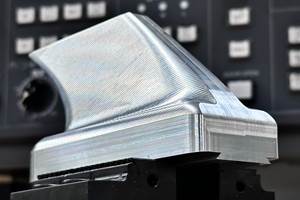What is a General-Purpose Electronic Height Stand?
Adaptable for many applications, this type of system offers several advantages over mechanical measurement solutions.
Share






An electronic height stand measuring system is a general-purpose system that is flexible enough for use in a variety of applications. It consists of a lever-style electronic gage head, high-performance amplifier and suitable gage stand. The gage stand, which uses the surface plate as a reference, allows for setting height and extending reach, and usually provides a fine adjustment for precise positioning. This allows the probe and readout much versatility.
The applications for this type of system are very similar to those of a mechanical test indicator and height stand. The types of measurement most commonly made on the surface plate require that the surface being measured is in a horizontal plane, parallel to the surface plate, and the distance to be measured is from the surface plate. The part need not rest directly on the surface plate, but parallels or step blocks can be used to raise the part off the plate while maintaining the parallelism of the surface to be measured.
Adaptable for many applications, the main purpose of height stands is to transfer height dimensions and compare specific part surfaces by referencing the dimension to a master setting. Common uses would include inspecting parts for parallelism, flatness and wall thickness variation, or measuring part runout when the item under test is rotated in centers or on Vees set up on the surface plate and positioned under the gage head.
Similarly, another application of the electronic height gage in surface plate work is the comparison of angles in conjunction with the use of a sine plate. In this application, the sine plate is used to set up the specific angle needed to set the part parallel to the surface plate. By referencing the electronic probe at one point and then sweeping along the surface, it is possible to detect and measure variations of surface flatness and deviations from the nominal angle set up with the sine plate.
Although similar in that they both provide surface plate measuring solutions, the differences between an electronic height stand gage and a mechanical test indicator stand are pretty significant. Probably the most obvious difference between the two solutions is the cost: The electronic height stand is apt to run five times the cost of the mechanical test indicator. However, there are several technical advantages to consider that might lead to selecting the electronic solution over the mechanical.
First, the sensitivity of the electronic lever head is apt to be significantly higher than the mechanical test indicator. Depending on the capabilities of the measuring system, some lever gage heads and amplifiers will provide resolutions to 1 microinch/0.02 micron. On the other hand, a good mechanical test indicator is likely to have a resolution of 0.0001 inch/2 microns.
Range also may be an advantage of the electronic solution, especially when combined with a digital amplifier system. The mechanical test indicator is a pure analog device in that it tries to balance range against resolution. To achieve high resolution, the mechanical test indicator has to limit range. Most of the amplifiers available today are digitally based, which allows them to provide long range with high resolution. Also, these amplifiers provide both digital and fast-response simulated analog displays. Therefore, for high-tolerance applications, the combination of long range, ease of set up, and the ability to resolve to submicrons means the electronic solution has an advantage.
While there is little difference between the size of the compact electronic head and the mechanical test indicator, the electronic readout also enables remote observation of the measurement. This makes it a lot easier to view dynamic measurements on large parts, or to use the amplifier signal for charting or collection of the measurements.
In trying to address surface plate measurement as tolerances are getting tighter and applications more diverse, the electronic height stand gaging system should be considered.
Related Content
6 Variations That Kill Productivity
The act of qualifying CNC programs is largely related to eliminating variations, which can be a daunting task when you consider how many things can change from one time a job is run to the next.
Read MoreCustom Workholding Principles to Live By
Workholding solutions can take on infinite forms and all would be correct to some degree. Follow these tips to help optimize custom workholding solutions.
Read MoreObscure CNC Features That Can Help (or Hurt) You
You cannot begin to take advantage of an available feature if you do not know it exists. Conversely, you will not know how to avoid CNC features that may be detrimental to your process.
Read MoreHow to Mitigate Risk in Your Manufacturing Process or Design
Use a Failure Mode and Effect Analysis (FMEA) form as a proactive way to evaluate a manufacturing process or design.
Read MoreRead Next
Machine Shop MBA
Making Chips and ¸ßĹâÂĘÁůşĎ˛Ę are teaming up for a new podcast series called Machine Shop MBA—designed to help manufacturers measure their success against the industry’s best. Through the lens of the Top Shops benchmarking program, the series explores the KPIs that set high-performing shops apart, from machine utilization and first-pass yield to employee engagement and revenue per employee.
Read MoreAMRs Are Moving Into Manufacturing: 4 Considerations for Implementation
AMRs can provide a flexible, easy-to-use automation platform so long as manufacturers choose a suitable task and prepare their facilities.
Read More




















